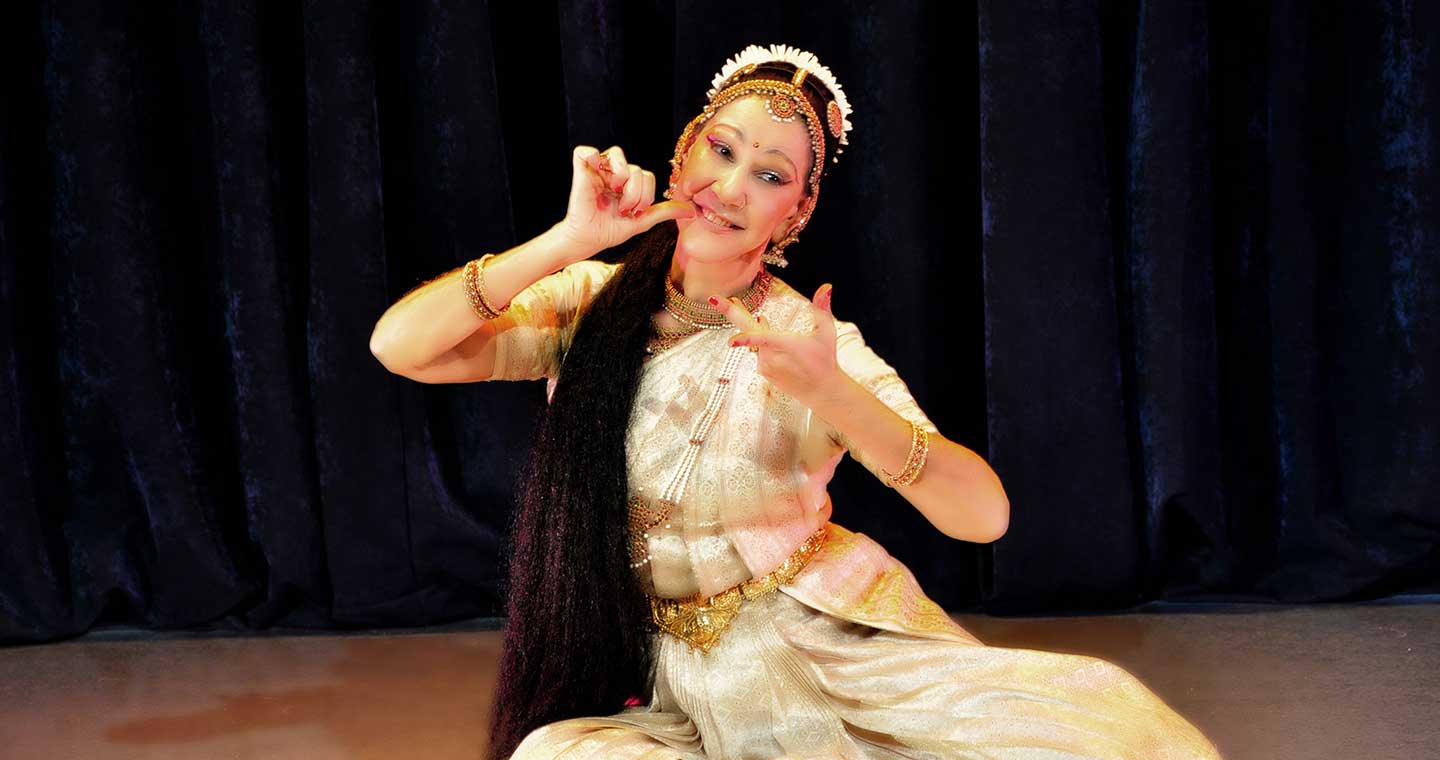Leda Shantala
Teacher of Indian classical dance and yoga, choreographer, dancer, dance movement therapist G.D.T.R. Sr. She is the daughter of singer Vassos Seitanidis and actress Smaro Stefanidou.
Studies

Graduate in French Literature from the Sorbonne III University.
Graduate of the Kaivalya Dhama Υoga Research Institution, in Lonavla (Puna) She studied yoga, theory and practice – deeply delving into the ancient texts of Indian philosophy- travelling all over India. Her teachers were sri Rocketti, Arnaud Desjardins (France), Leopoldo Chariars (Argentina), Baba Khan (Egypt) and in India, Swami Satyananda, B.K.S Iyengar, T.K.V. Desikatchar and many others, mostly Vedanta teachers.
She learned with many great contemporary yogis and sages. She has repeatedly stayed at the ashram of sri Ramana Maharshi, Ramdas, Ma Amritananda Mayi, Shankaracharya (Chennai). Since 1989 she is practicing meditation with the sage sri Chandra Swami Udasin (in northern India). She graduated from the Indian Dance Academy «Bharata Kalanjali» and the «Abhinaya Sudha» school of expression in Chennai (formerly Madras). For three years she was trained in the art of classical Indian dance Bharata Natyam by the most distinguished teachers, her gurus being sri Adyar Lakshman, V. P. Dhananjayan and smt. Shanta Dhananjayan, smt. Kalanidhi Narayanan.
At the same time, she studied Carnatic music and especially song, rhythm (tallams), the art of rhythmic syllables accompanying the dance (sholus) and the execution of rhythms on the “tata-kari”, a small xylophone. On April 24, 1983, she gave her first public performance (arangetram) at the Anantapadmanabha Swami temple in Adyar, Chennai, getting excellent review.
She has the title of G.D.T.R. Sr (Greek Dance Therapy Registered Senior), she is a member of the Dance Movement Therapy Institute, the Australian Dance Movement and the Greek Association Of Dance Therapists.
She is the only Western researcher worldwide who was accepted by the Mitsogo tribe, at the Mimongo village at the south of Gabon, to be taught the “Mombwiri”, a primeval dance therapy and healing form. Her teacher was Maman Mabé. Later on, wishing to give to this knowledge a Western scientific framework, she studied the American dance movement therapy system with Dr. Μarcia B. Leventhal (reader in New York University).
In 2010, she was back in Africa, for the advanced stage of her training, where she was given the local honorific title “Ntzogo Polo”- “the one who knows the secrets and helps others”.
Moreover
She has made extensive trips all over the world to research different dance forms, and look for sources of inspiration:
- To Bali, Indonesia, where she studied the use of mask in the traditional “Topeng” temple theatre, under the guidance of the great choreographer, dancer and teacher Babak I. Made Djimat.
- To India, where she studied the use of mask in the Chhau art form of Seraikela (Orissa), with L.R. Acharya and Shashidhar Achary.
- n Sri Lanka, where she studied dances associated with the removal of psychosomatic illnesses.
- In Mexico, where she studied the traces of the ancient dances of the Maya.
- In Congo, Gabon, Cameroun and Dahomey of Central Africa, where she studied the relationship of movement and dance with the expansion of consciousness, self-therapy and discovery of the internal stability forces of movement.
Note: During her trips in the equatorial jungle, she collected authentic ritual masks -originally used for ancestor worship-, which she sometimes uses in her performances (some of them are displayed in Shantom).
Greece
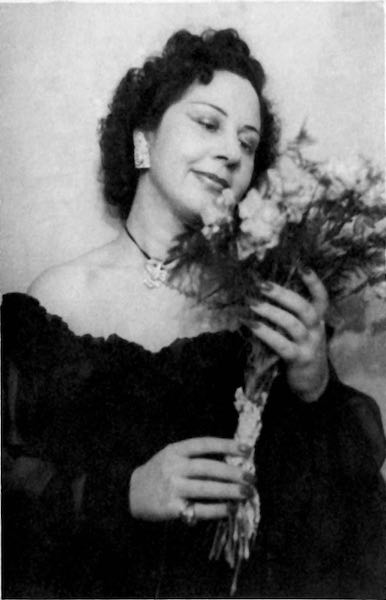
Leda – Irene was born in Athens. She started dance lessons at the age of 6 and went on for ten years, studying ballet and contemporary dance with Hero Sismani and Nassouka Himara.
Her maternal uncle Kostas Stefanidis, a chemist and translator of theosophical and philosophical texts, was one of the first members of the Theosophical School and had translated the Indian epics “Ramayana” and “Mahabharata”, as well as many other Indian books. He was the one who planted in her the seed of philosophical research. In family gatherings she had the chance to enjoy his thoughts and listen to his interesting stories. Τhus, at that time, her special bond with India had started to form. “It is a strange thing. Since I was a child, every time I happened to listen to Indian music I burst into tears!”
Her father’s death, when she was twelve, was a huge shock. It was then that she started to search for answers to important questions: where do we come from, where are we going, what is life and what is death, what is humankind.
“I tried to heal my pain and get answers to my questions in my uncle’s books, which I found in our family library. I talked with him about the root of religions, I gradually started reading about Western and Indian philosophy. My father’s death was a great blow and those talks and readings gave me comfort. Until the age of seventeen, I read a lot and delved into philosophy a lot”.
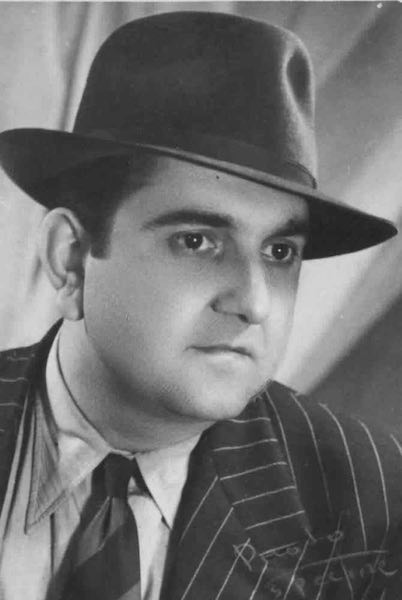
France
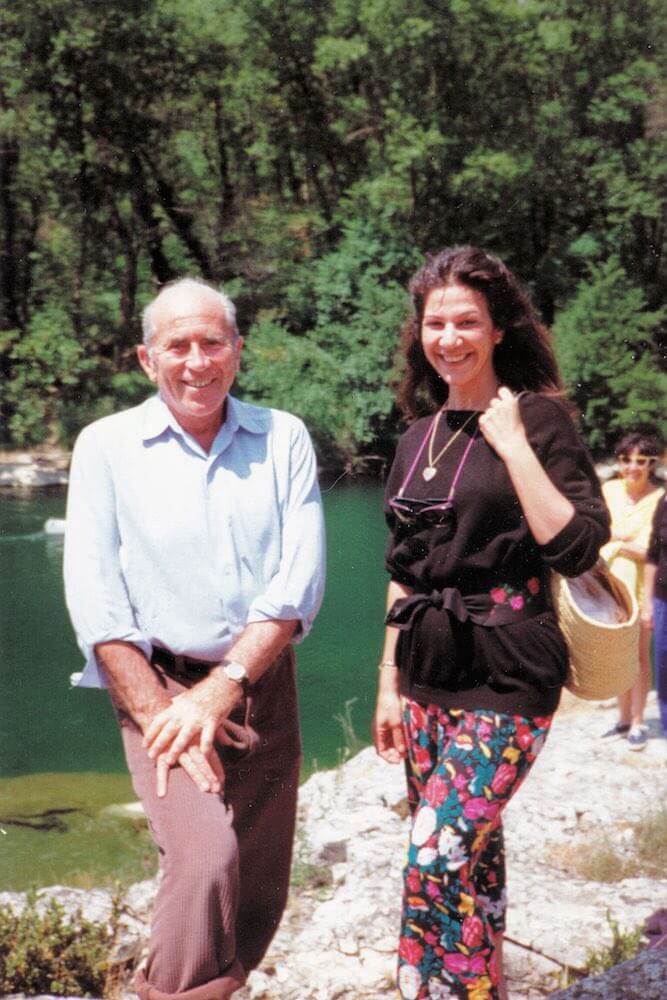
At the age of eighteen Leda left for Paris to study French Literature at the Sorbonne University. At a time where the student movement of May ‘68 had left profound marks. Alongside her studies, she attended intensive contemporary dance workshops as well as courses on drama, ethnology, humanistic psychology (theoretical and practical, with specialization on the body image and its symbolism). It was there that she first delved into self-research through body-mind psychotherapeutic methods – mostly Reich, Gestalt, rebirth, primal scream, bioenergetics, at the famed Open University of Vincennes. It was there that she first found yoga, a course that a professor of linguistics had managed to insert as a university course. Her French teacher invited all the great yogis who came on tour, and that’s how she had the opportunity to meet, right from the start, important teachers.
“My first experience with yoga was enough to make me realize that it was exactly what I needed, a complete answer to what my body and my soul needed”.
Later on, in 1976, still a student, she made a trip to Bali, Indonesia, where she saw for the first time a dance performance based on the Indian classical dance Bharata Natyam, one of the most ancient dances in the world, combining poetry, music and dance. She immediately fell in love. As soon as she came back to Paris, she had the chance – maybe it was fate – to see a performance of authentic Indian dance. Then she looked for a place to learn, and found the Mandapa School, at the 16th arrondissement, where she took intensive lessons, for a year. Although she had years of ballet training behind her, Bharata Natyam was entirely different. A very demanding and deeply spiritual dance. As time went on Bharata Natyam enchanted her more and more. “This dance is a spiritual way to transcend one’s self. A way to understand the reality of life which is beyond art. Bharata Natyam brings me to the centre of my being.”
India

After the end of her studies in France (dipl. Licence es Lettres, Paris III Sorbonne), she travelled to South India, following a powerful call of the soul felt since childhood, for the land of philosophers, yogis and myths:“It was a trip which I needed to make. I was searching for answers to the question of who I really am and what I want”. It was a difficult trip: “Difficult because I didn’t know whether the next evening I would have a place to sleep, whether I’d find something to eat, whether I’d have to face illnesses that plague foreigners unused to the climate. India is not France”.
She went through Pakistan, making a stop at the Kailash valley, to see the population that traces its ancestry to Alexander the Great. From there she crossed to India, down to Madras (today’s Chennai), in South India, the centre for Bharata Natyam dance.
In a simple room outside the town (that she had to reach on bike), with a mattress on the floor, a mosquito net and a little kerosene stove for cooking, her daily life was taken up by hard work, as she took dance and yoga lessons at the same time.
The aim, in those difficult times, was internal autonomy, regardless of external circumstances: “I lived those years as if in a deep tunnel, to emerge liberated, because through those studies I discovered truth and light”.
There she felt an inner transformation and from Seitanidou she became Shantala, to differenciate her social life from her artistic life. Leda Seitanidou is the social person, and her roots are in Greece and Asia Minor. Shantala is the dancer, who was born in India.“Bharata Natyam changed my whole life. It was like a new birth, a new personality. To mirror this change inside me, I was given a new name”.
Shantala comes from the Sanskrit word shanti (meaning peace, as her second Greek name, Irene: “Indians believe that the sounds of our name influence our whole personality. I already had L and S in my name, so I found a name incorporating those two sounds”.
Shantala is also an illustrious name, the name of a Hoysala queen of the 13th century, who lived in the state of Mysore in South India. She was a great dancer, her dance inspired many myths as well as temple sculptures. Tala in sanscrit means rhythm. In that sense, Shantala may be the one who finds peace through rhythm.
Africa
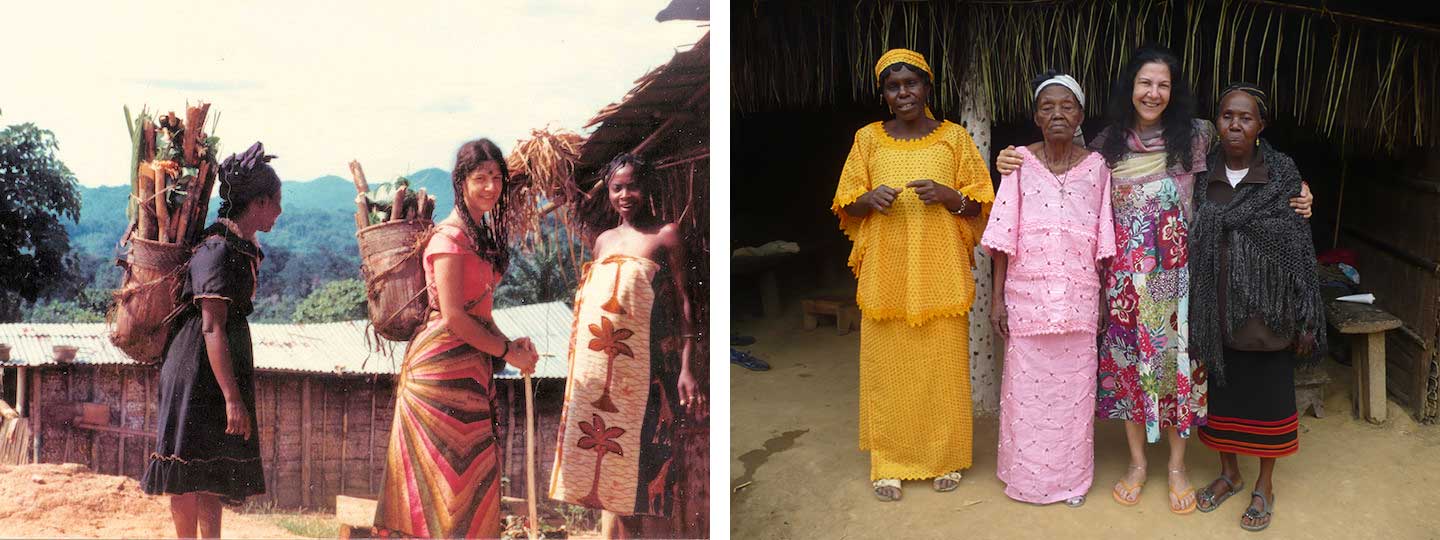
From India, Leda decided to leave on a trip of exploration in Gabon, Africa, to research “group therapies”, and more specifically the Mombwiri healing ritual of the Mitsogo tribe, methods that often includ the arts of dance and theatre. It was there where she discovered that ancient dances (like Bharata Natyam), are not only “the contemplation of the world in a state of grace” but also develop a strong field of energy, such as to bring both the dancer and the audience in an hypnotic trance. This realization, enabled Leda herself to dance on burning coals without getting hurt.
There, in the heart of Africa, she went through exacting initiation rites and was finally given the name of “Mama Naganka”. For about two years she was taught methods that although coming from so-called primitive societies, incorporate ideas and therapeutic approaches that only today Western science has begun to discover. A therapeutic framework based on living experience which unfolds non-rationally, in a mythological way: “The ritual art forms of India and Africa are means of unblocking all tensions and energies blocked inside us. Their goal is to reach the essence, the core”.
The comeback
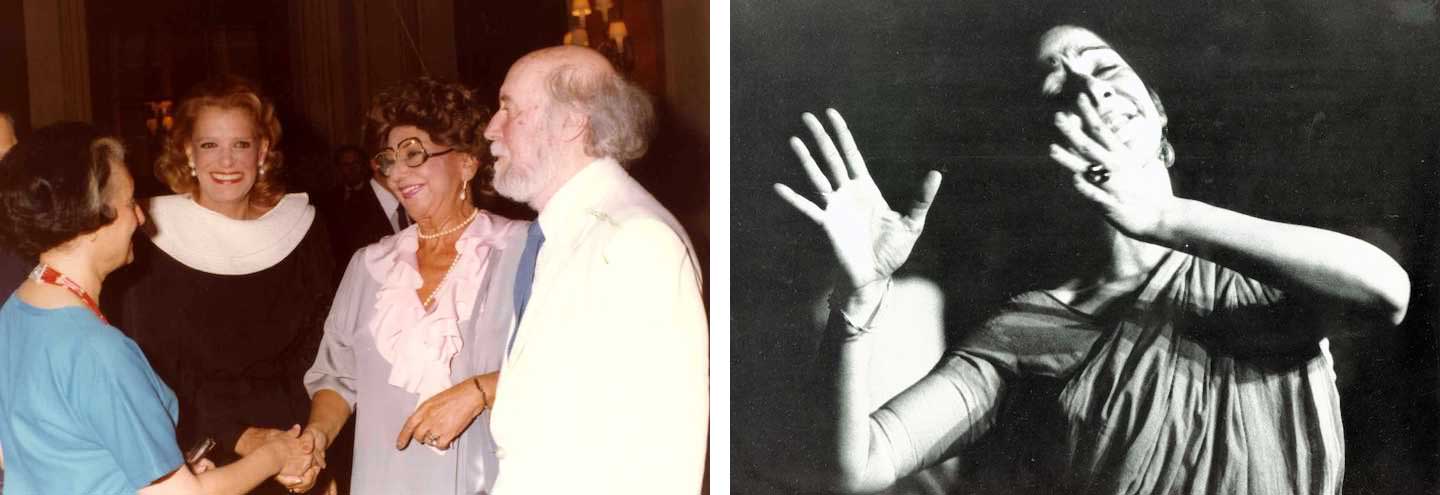
The first performance she gave in Greece, in 1985, was for a small audience chosen from the world of literature and the arts such as painter Yannis Tsarouhis, Nobelist poet Yannis Ritsos, Yannis Migadis and many well-known actors and journalists. A little later she performed Bharata Natyam in an event organized by the Indian Embassy at the Athens Cultural Centre. Followed a recital at the small open-air theatre of the Parko Eleftherias. Both performances made a stir. This was only the beginning.
In the same year, she founded the “Mandiram Cultural Centre”, an innovative institution of multi-cultural character. It is there that Leda, for almost twenty years, put into practice her rich experience and knowledge through Bharata Natyam and yoga lessons as well as dance therapy sessions, bridging modern knowledge and Western scientific methods with the healing and spiritual traditions of ancient cultures. The Mandiram Centre is home to the only professional school of Indian classical dance (practice and theory) in Greece.
Since November 2003, all activities of the Mandiram Centre have shifted to the new Shantom House of Culture.
The "Leda Shantala Dance Theatre"
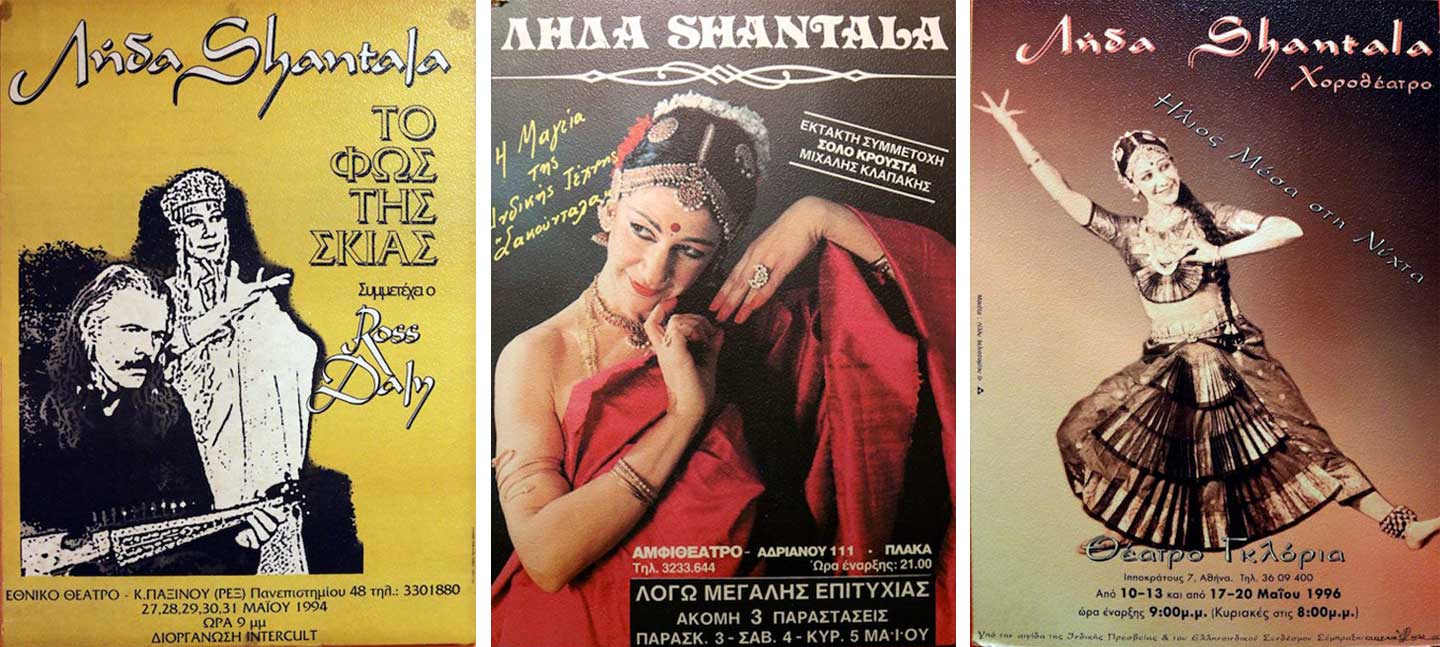
In 1987, Leda founded the “Leda Shantala Dance Theatre”, through which she translates her inter-cultural research into performances.
Performances of pure classical Indian dance gradually gave their way to composite shows, where Bharata Natyam coexists (without mixing or adulteration) with contemporary dance. These performances are inspired by dance idioms from all over the world, merging ancient and contemporary dance codes into a new choreographic language. They incorporate different techniques such as theatre, dance, mask, myths and body communication codes, in a holistic creation.
The Dance Theatre has presented until now 13 original productions and many classical recitals in Greece and abroad, collaborating with notable Greek and foreign artists: Painter Yannis Tsarouchis, actress Smaro Stefanidou. Directors Roula Pateraki, Nikos Sakalidis, Vassilis Nikolaidis, Takis Manolopoulos. Choreographers V.P. Dhananjayan, Smt. Kalanidhi Narayanan, Nirupama Nityanandan. Composers Ross Daly, T.K. Padmanabhan, Adyar Lakshman, Reji George. And many more Greek and Indian musicians and dancers.
Leda Shantala keeps in touch with the roots of Bharata Natyam and regularly travels to India to create new performances and also renew and enrich her knowledge, collaborating with her ex-teachers as a colleague.
Multi-faceted cultural offerings and activities
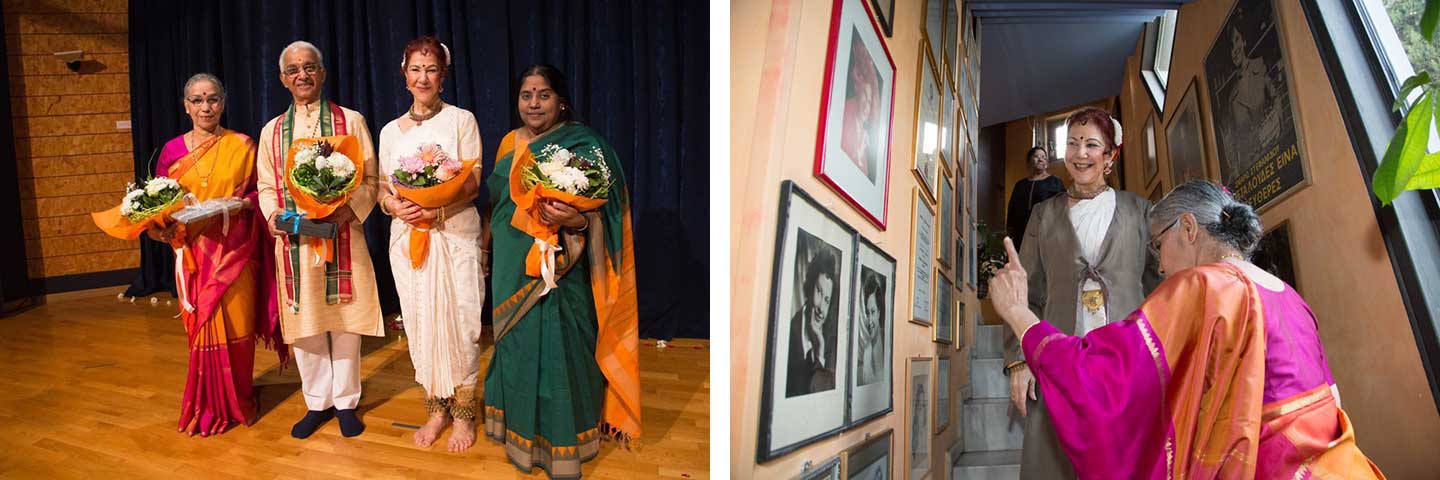
Leda Shantala has danced, taught, given lectures and workshops, collaborating with many organizations all over the world:
- In Greece: Mandiram Centre, Hellenic-American College, Panteion University, International Theatre Centre of Delphi, Shantom House of Culture etc.
- In France: «Les amis de Font d’Izière», «Centre Mandapa».
- In India: «Abhinayia Sudha» and « Bharat Kalachar » (Chennai), «Indira Gandhi National Centre for the Arts» (N. Delhi) and «Sadhana Kendra» (Rishikesh).
As a choreographer, she has worked on ancient drama performances such as “Hippolytus” (National Theatre, in Epidaurus) and Y. Tsarouhis highly acclaimed rendition of “The Trojan Women” (International Meetings of Ancient Drama, Delphi, 1985).
She still travels a lot, everywhere in the world, searching for new sources of inspiration for an authentic and original artistic creation, beyond frontiers.
In 2006 she co-wrote, with Irene Maradei, the book "Bharata Natyam", on the Indian classical dance. Spanning a vast array of subjects related to the Indian classical dance, it touches on history, famous dancers, themes (including a presentation of the main Indian gods), technique (including a detailed chapter on Abhinaya), a guide to costume and jewellery, performance, a glossary of terms, useful resources and even translates the lyrics of many of the most well-known songs used in dances. Invaluable both for would-be dancers and for enthusiastic audiences.
Theoretical research
For the past 15 years Leda Shantala's theoretical research has been focused on the following subjects, presented in papers and lectures.
1. Relationship of “Musike”, the Ancient Greek art of the Muses, with the Indian classical art form of Bharata Natyam
The ancient Greek art form called "musike" consisting of dance, music, theatre and poetry, presents profound similarities with the Sanscrit art form Natya. According to Plato, the muse Terpsichore could express any idea with her hand gestures. This art, "cheironomia" (which in Greek means "the law of hands"), was an elaborate alphabet of gestures, very similar to classic Indian "hastas" and "mudras": an art gradually lost with the rise of Christianity in Greece, although some elements survive in the theatrical practice of tragedy performances.
2. Ancient Roots of Dance Movement Therapy in India and Greece
A comparative approach to the ancient Greek art of "musike", and the Indian classical dance Bharata Natyam.
Both these arts, because of their holistic approach, are offered today as an example of an art that respects and honors the evolutionary process of the human being searching through all the activities of life to discover and experience the core of his or her existence. By their nature they belong both to the field of arts and to the field of healing. Although ancient, they include very modern ideas about the nature of art as a therapeutic mode and means of self-knowledge.
Subsidies and honorary distinctions
- 1991-1992: Subsidy from the Ministry of Culture for the performance “Shakuntala” of the Leda Shantala Dance Theatre (3 million drachmas).
- 1992-1993: Subsidy from the Ministry of Culture for the performance “Heros Anghelos “The Messenger of Spring” of the Leda Shantala Dance Theatre (3 million drachmas).
- 2000 -2001: Subsidy from the Ministry of Culture for the performance “On The Roof of the World 2” of the Leda Shantala Dance Theatre (6 million drachmas).
- 2000: State subsidy for the construction of the building housing the Shantom House of Culture (3 million drachmas).
- 2000: “Indira Gandhi Award” by the Ιndira Gandhi National Center for the Arts, for the high quality of the Leda Shantala Dance Theatre productions (10 thousand rupees).
- 2006: “ Saraswati” Award by the Sadhana Kendra Society, for the high quality of the Leda Shantala Dance Theatre productions (15 thousand rupees).
- 2007: “Kalyana” Award by the Indian Embassy in Greece, for the overall activity of the Leda Shantala Dance Theatre (symbolic medal).
- 2022: She was honoured by the EICBI (Europe India Centre for Business Industry), and chosen to be one of the 60 people (60 legends, that include politicians as well as exponents of the arts, history and literature)) from Europe and India who EICBI believes have played a key role in influencing EU-India relations over the past 60 years. EUIndia60 Legends Coffee Table is an e-book listing those eminent personalities. Leda was chosen because she introduced Indian classical dance in Greece and, with the Leda Shantala Dance Theatre, made it popular with Greek audiences, as well as for her services to Yoga and Indian philosophy. See more here. Leda's profile is on page 35 of the Coffee Table e-book.


